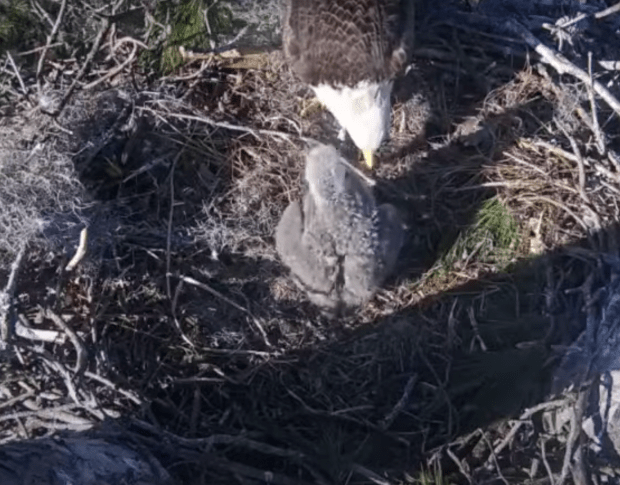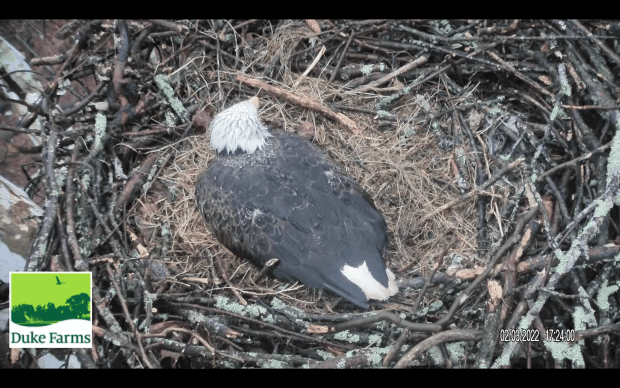Oh, we started out with more snow this morning! And with it came the return of the European Starlings – a few of them! The phone caught the flakes coming down reasonably well. For now it has stopped and the small feeders with the butter bark, mealworms, and hand chopped peanuts have been filled for the third time. Gosh, they love those mealworms in the winter.

Poor things. This is before we cleared a bit between the piles of snow. You can see one Starling down with thee Sparrows trying to find seed that had dropped from the feeder.

There are at least 60-75 House Sparrows (at a quick count) in the Lilacs. Dyson, our seed sucking Grey Squirrel, has found a litre of Black Oil seed in the square feeder with the dome. He sits and eats and sways like he has his own personal swing. No one bothers Dyson when he is eating but they do hope he gets off balance and dumps a lot of seed below. We won’t tell Dyson that in the evening we put our special food under that feeder for Hedwing, the garden rabbit, who has been showing up at dusk and dawn and sometimes in the middle of the night. It appears he lives under our deck.

So my birds are fed and as happy as they can be til the wind and the snow start again in a few hours.
There is some good news in the world today and there is some very sad news regarding wildlife. Lots of animal rights issues rising to the top of the news. Brief highlights:
The City of Dallas, Texas is protecting two of the cities favourite raptors!
As Dallas protects, people in Britain are calling for criminal charges to be laid to the individuals that killed 2 of the 5 White-tailed Eagles reintroduced to the Isle of Wright. The shooting took place near or over a shooting estate. Chris Packham and other environmentalists have called for the end of killing animals for fun!
Criminal charges have also been laid against one of England’s footballers for dropping and kicking his cat. The fine is set at 250,000 GBP – yes, you read that right. You can find the story on line if you are interested. Now if we could please get all authorities involved and people educated on the rights of animals – and our beloved birds.
The one thing that sent my granddaughter to becoming Vegan six years ago was the culling of male chicks. At the time they were simply tossed alive into a machine not unlike a wood chipper. Today, Germany has ended the practice of culling the male chicks from the females.
Everyone continues to wait to see how the current H5N1 highly pathogenic avian flu will impact European birds. It has been around since 1998 according to virologist Thijs Kuiken. It is rearing its head this year in the UK and has already crossed the Atlantic into Newfoundland, Canada. At least one wildlife rehabber has had almost all the birds in their care killed because of it. Very sad. That was the Whitby Wildlife Centre. They will not be able to resume caring for the wildlife injured for at least 1 year, perhaps 2.
The camera is working on the Port Lincoln Barge and so is the sound. We just can’t see anything but the deck! Ervie was definitely there earlier. I had to turn the sound down. He even sounded like he was getting hoarse and then everything stopped. I hope he got a fish or flew off to find one.

Gabby and Samsons, NE26 and 27 are really changing. They are certainly no longer little fluffy balls. Today they had the rest of the bird on the nest following by some fish. They were really full!
The weather has really improved in Jacksonville.



It is a gorgeous day to incubate eggs over at Duke Farms in Hillsborough, NJ.

OGK has returned after three days at sea to relieve his mate, YRK at Taiaroa Head, New Zealand, home to the Royal Albatross. The image below is actually of YRK feeding the Royal Cam chick that I took late last night. How touching.
To date 26 Royal Albatross eggs have hatched out of 35. The other 9 will not hatch due to embryo deaths.

Dennis Brecht makes frequent and regular visits to the nest of The Love Trio on the Mississippi River near Fulton, Illinois. So far this year he has not spotted Valor I working with Starr and Valor II on the nest. This trio was extremely unique and popular. The question is: does Valor I have his own nest or has something happened to him? We wait for an answer. Brecht has contacted the Stewards of the Mississippi for assistance and finding the answer to the mystery.
The Ventana Wildlife Society is releasing a few condors into the wild currently. One of those was Condor 340 who was treated for lead poisoning.
Condor 340 hatched in 2004 in the Oregon Zoo. Its name is Kun-Wac-Sun. It was released into the Pinnacles National Park in 2005.

Wheeee. How beautiful. A wild Condor flying free again in the Pinnacles.

Kincaid at the Kisatchie National Forest Bald Eagle nest of Anna and Louis was 4 weeks old yesterday. Oh, this eaglet is getting so big! Finishing up getting its thermal down and you can see the tips of a few juvenile feathers.

I was so happy to see the Captiva Osprey Cam back up and running. Lena is rolling eggs and calling Andy wanting a fish and a break.
You can see the three beautiful eggs. Oh, let us all hope that by laying their eggs a month early this couple will be able to fledge Osprey chicks off Santibel Island.
Hatch watch begins this weekend.

Those are just a few of the many nests to check on. I am really hoping to see Ervie today with a fish! Take care everyone. Thank you for joining me.
Thank you to the following for their streaming cams where I took my screen captures: Port Lincoln Osprey, Captiva Osprey Cam, NEFlorida and the AEF, Duke Farms, KNF Bald Eagles, Cornell Bird Lab and the NZ DOC, and Ventana Wildlife.


























































